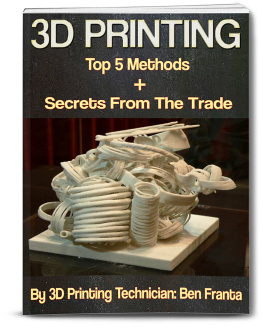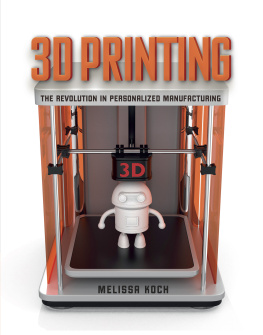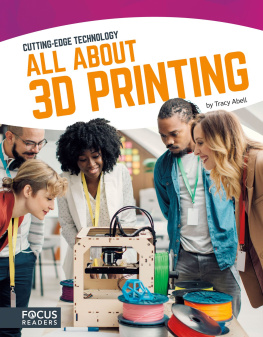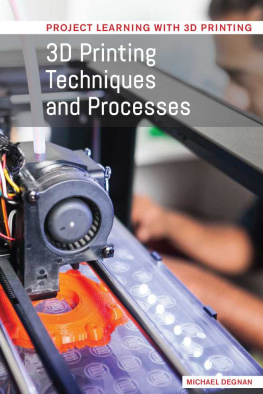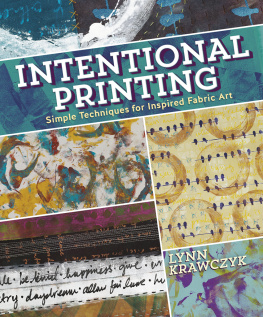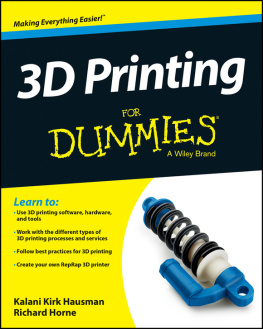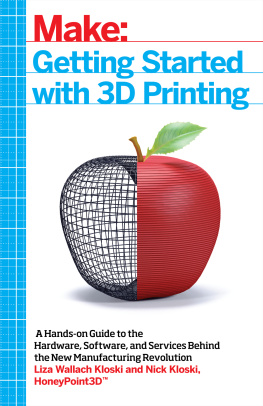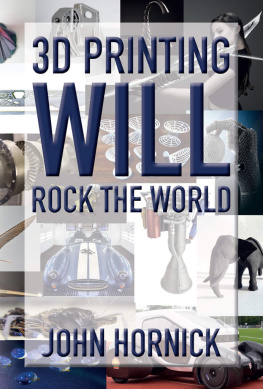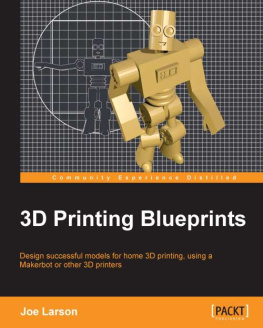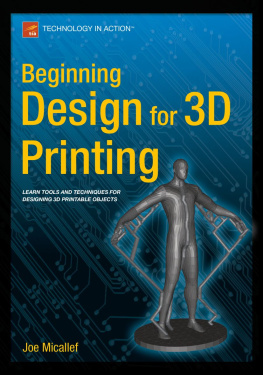Franta - 3D Printing: Top 5 Methods Secrets From The Trade
Here you can read online Franta - 3D Printing: Top 5 Methods Secrets From The Trade full text of the book (entire story) in english for free. Download pdf and epub, get meaning, cover and reviews about this ebook. year: 2015, publisher: By 3D Printing Technician: Ben Franta, genre: Romance novel. Description of the work, (preface) as well as reviews are available. Best literature library LitArk.com created for fans of good reading and offers a wide selection of genres:
Romance novel
Science fiction
Adventure
Detective
Science
History
Home and family
Prose
Art
Politics
Computer
Non-fiction
Religion
Business
Children
Humor
Choose a favorite category and find really read worthwhile books. Enjoy immersion in the world of imagination, feel the emotions of the characters or learn something new for yourself, make an fascinating discovery.
- Book:3D Printing: Top 5 Methods Secrets From The Trade
- Author:
- Publisher:By 3D Printing Technician: Ben Franta
- Genre:
- Year:2015
- Rating:3 / 5
- Favourites:Add to favourites
- Your mark:
- 60
- 1
- 2
- 3
- 4
- 5
3D Printing: Top 5 Methods Secrets From The Trade: summary, description and annotation
We offer to read an annotation, description, summary or preface (depends on what the author of the book "3D Printing: Top 5 Methods Secrets From The Trade" wrote himself). If you haven't found the necessary information about the book — write in the comments, we will try to find it.
Franta: author's other books
Who wrote 3D Printing: Top 5 Methods Secrets From The Trade? Find out the surname, the name of the author of the book and a list of all author's works by series.
3D Printing: Top 5 Methods Secrets From The Trade — read online for free the complete book (whole text) full work
Below is the text of the book, divided by pages. System saving the place of the last page read, allows you to conveniently read the book "3D Printing: Top 5 Methods Secrets From The Trade" online for free, without having to search again every time where you left off. Put a bookmark, and you can go to the page where you finished reading at any time.
Font size:
Interval:
Bookmark:
3DPRINTING
Top 5 Methods
+
Secrets From The Trade
By 3DPrinting Technician: Ben Franta
Copyright 2015
All rightsreserved. No part of this book may be reproduced, stored in a retrieval system,or transmitted in any form or by any means, electronic, mechanical,photocopying, recording, scanning, or otherwise, without the prior writtenpermission of the publisher.
Disclaimer
All the material contained in this book isprovided for educational and informational purposes only. No responsibility canbe taken for any results or outcomes resulting from the use of this material.
While everyattempt has been made to provide information that is both accurate andeffective, the author does not assume any responsibility for the accuracy oruse/misuse of this information.
About the Author
Hello and thank you for choosing my quick learningguide! My name is Ben Franta and I wasborn in America during the year 1987 (surprisingly around the time 3D printingwas invented!). I have 2 college degrees, an Associate in Computer Design andAnimation Engineering and a Bachelors of Science degree in Technology. I havebeen very fortunate to land my first career in the field of AdditiveManufacturing (3D Printing). I work with a variety of 3D printers every day andalso have close relationships with companies who also use additivemanufacturing processes. I also continuously research 3D printing technologyevery day to see what new innovations are surfacing in the world. Thistechnology is very fascinating to me and I really enjoy teaching it to peoplewho are unaware of it or who want to learn more about it. Enjoy!
Preface
This guide is intended to give you a quickunderstanding of how 3D printing works and what specific processes are beingused today. Below is a list of what you will learn:
Brief Summary of 3D Printing
Current Printing Processes
Quick Learning Summary of EachPrinting Process
Deeper Understanding of EachPrinting Process
What The Strengths and WeaknessesAre of Each Process
Secret Tips For DesktopPrinting Applications
What The Future May Hold
Table of Contents
Common Questions:
HowLong Has 3D Printing Been Around?
Answer: Since the mid 1980s. Chuck Hull (Co-Founder of 3DSystems) inventedthe SLA printing process. Stereolithography or SLA is a very common 3D printing process usedtoday. Details to follow.
WhoHas Been Using It All This Time?
Answer: Mostly larger scale companies whoare involved with new product development. More recently the technology has expanded to smaller businesses andeveryday hobbyists.
Why3D Printing?
Answer: 3D Printers can create hundreds ofdifferent parts in a single build within a day or two. This saves companies timeand money when developing new products. Why? Although not as durable, it isextremely faster and more cost effective than traditional manufacturing methodssuch as CNC machining. Computer Numerical Controlled machines that cut awaymaterial from raw stock (mostly metal or plastic blocks or tubes). This method requires a very skilledprogrammer to setup and build parts which takes a lot of time (up to over amonth) and effort. But please understandthat CNC machining/traditional manufacturing methods will not be replaced by 3Dprinting anytime soon. However, traditional manufacturing methods must adaptand work with 3D printers (which is already happening). Today, 3D Printed partsare nice for quick fit testing (during new product development) but they wouldnever last as long as a machined or molded part.
SoI Can Create Anything If I Bought a Desktop 3D Printer?
Answer: No! Please do not buy into thishype that the media and start-up companies have been spewing out over the pastfew years. Dont get me wrong, you cancreate some very meaningful and helpful things with them (i.e. prostheticarms/hands to simple fixtures to help around the house) but do not expect todesign and print something and it to be functional or even comparable to anon-the-shelf product for long. Mostdesktop printers today are very unreliable and take a lot of patience(tinkering with the printer and refining design so the object isprintable). So please be a bit scepticalwhen you read headlines that read 3D printing is revolutionizing the way partsare created/manufactured! This may ringtrue sometime in the future, pending a great breakthrough, but just not rightnow.
Rapid Prototypes for NewProduct Development (consumer products)
Quick Fixtures for Lab Testingand Machining Operations
Health Industry for NewImplants or Pre-Op Practices/Learnings
Dental Industry for Repairs orNew Tooth Implants
Jewelry Industry for CustomApplications
Architects for Quick Builds ofSmaller Scale Model Homes or Buildings
Hobbyists
Quick Summary:
3D Printing, also called AdditiveManufacturing, is a process where a 3D physical part is created by printing oradding very thin layers (as thin as the hair on your arm) of material on top ofeach other until the part is complete. Each part comes from a computer aided drawing program. The part is sent to the 3D printer where itwill process or slice the 3D computer generated part into hundreds or eventhousands of slices. As the printer laysdown material, it will only see one slice or cross-section at a time during theprinting process. When the first layeris done printing, the printers head or print bed will move up or down allowingroom for the next layer to be printed. Each layer is cured to the previouslayer until the part is complete.
*Helpful Note: If you are more of a visuallearner, like me, there are numerous videos on the internet that will help youvisualize each method. I recommend SolidConcepts videos.
From my personal experience, I would haveto conclude that there are only around 3 to 4 printing methods out today. Although you will learn about several processin this book, you will soon understand that they all seem to use the samemethods but just slightly different than its predecessor. The processes that I feel are the mostimportant to learn and understand are as follows get ready for anacronym blast!
FDMFused DepositionModeling (MakerBot uses thistechnology). For now you can think of this process as if it were like acomputer controlled glue gun that deposits plastic on the build platform. Moredetails to follow later in this guide.
Polyjet/Multijet This is where photopolymer resin is depositedby hundreds of print nozzles. A UV light cures the fresh layers of photopolymerwith each deposit/pass. This process is similar to your inkjet printer at homeexcept it uses actual plastic polymer instead of ink.
SLAStereolithography This is where a vat of liquid photopolymer is cured by a computercontrolled UV light beam. The light beamtraces each layer/cross-section of the part curing it to the previous layer.
SLSSelective LaserSintering This uses a similar process as SLA but instead of liquidphotopolymer it uses powdered material, usually metal or plastic. The laser beam traces each cross-sectionsintering the powdered material together. This means the powdered material isheated up just enough to bond but not melt to each other as meltingwould cause the part to deform. Eachnewly sintered cross-section bonds with the previous layer.
DMLSDirect Metal Laser Sintering Similar to SLS, this is wherea thin layer of metal powder is spread across the build platform. A computer controlled laser, typically fiberoptic, will then trace the first layer of the part sintering the powderparticles together. Sintering means thatthe laser heats up the metal powder particles just enough to make them bond toeach other but they do not completely melt together.
Font size:
Interval:
Bookmark:
Similar books «3D Printing: Top 5 Methods Secrets From The Trade»
Look at similar books to 3D Printing: Top 5 Methods Secrets From The Trade. We have selected literature similar in name and meaning in the hope of providing readers with more options to find new, interesting, not yet read works.
Discussion, reviews of the book 3D Printing: Top 5 Methods Secrets From The Trade and just readers' own opinions. Leave your comments, write what you think about the work, its meaning or the main characters. Specify what exactly you liked and what you didn't like, and why you think so.

